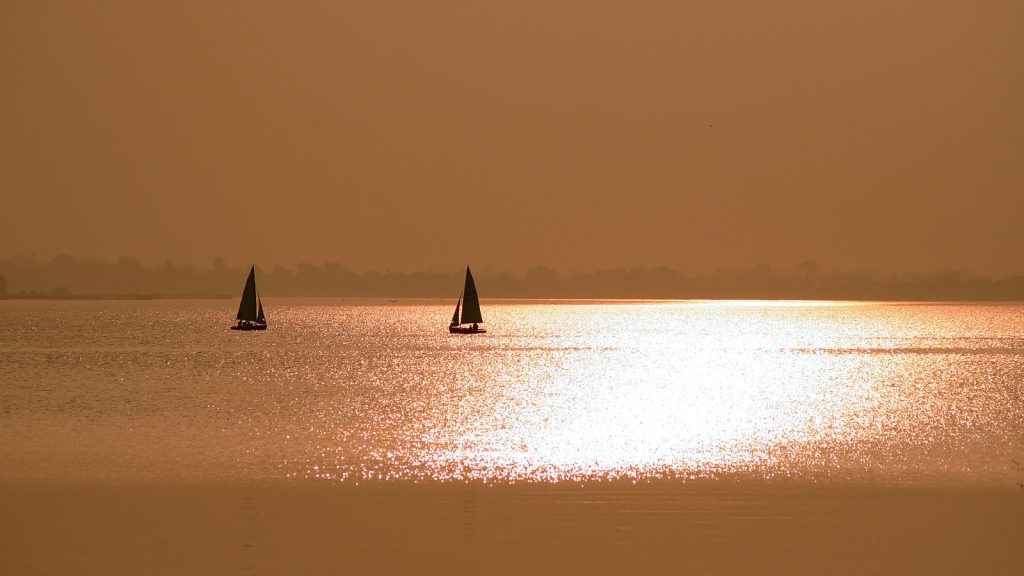The Story of the Upper Lake

Imagine a lake so vast that it once covered 422 sq. km—spanning across forests, villages, and mountains, creating one of the largest man-made water bodies in Asia.
This is the story of Bhopal’s Upper Lake (Bada Talab), a 1,000-year-old water marvel built by Raja Bhoj, the legendary king of the Paramara dynasty. From being a life-giving reservoir to achieving Ramsar Wetland status, this lake has shaped Bhopal’s history, ecology, and urban development.
Let’s explore how this engineering marvel of the past continues to define Bhopal’s identity and future!
The Visionary Behind the Lake – Raja Bhoj’s Water Revolution (1010 AD)
Raja Bhoj (1010 – 1055 AD) was not just a warrior king but also a visionary ruler who understood the importance of water management and urban planning.
According to legend, Raja Bhoj suffered from a chronic skin disease, and his royal physicians advised that bathing in the waters of 365 rivers could cure him. Since no such lake existed, the king decided to create one!
How Was the Lake Built?
- Raja Bhoj identified a natural basin between two hills (Bhojpur & Kolar) where several small rivers and streams merged.
- He ordered the construction of an enormous earthen dam across the Betwa River, trapping the water and creating a massive artificial lake.
- The reservoir stretched over 422 sq. km, submerging 365 villages and transforming Bhopal into an oasis of prosperity.
This was one of the most ambitious water conservation projects in Indian history—built 1,000 years ago!
The Evolution of the Upper Lake
Over time, dynasties changed, rulers came and went, and the lake adapted to new needs.
By the 18th century, the lake had begun to shrink due to natural silt deposition and human activities.
During British rule, the Nawabs of Bhopal restored parts of the lake, recognizing its importance as a water source.
However, the biggest transformation came in the 20th century, when Bhopal became the capital of Madhya Pradesh. The lake was no longer just a historic water body—it became the backbone of Bhopal’s modern urban ecosystem.
The Upper Lake Today – A Ramsar Wetland & Ecological Marvel
In 2002, the Upper Lake was declared a ‘Ramsar Wetland Site’, marking it as a globally significant water ecosystem.
Why is the Upper Lake Ecologically Important?
Bhopal’s Lifeline: The lake provides drinking water to over 40% of the city’s population.
Biodiversity Hotspot: It is home to more than 200 species of birds, including migratory species from Europe and Central Asia.
Fisheries & Livelihood: The lake supports fishing communities, farmers, and local businesses.
Climate Regulation: It helps maintain temperature balance and prevents urban heat islands.
From a king’s vision to a UNESCO-recognized wetland, the Upper Lake continues to sustain Bhopal!
The Upper Lake – A Hub of Recreation & Culture
Beyond its historical and ecological significance, the Upper Lake is also the heart of Bhopal’s cultural and recreational life.
Attractions Around the Lake:
Kamla Park & VIP Road – The best place to enjoy a panoramic sunset view.
Boat Club & Water Sports – A hotspot for kayaking, speed boating, and paddle boating.
Taj-ul-Masajid Reflections – The lake beautifully mirrors one of the largest mosques in India.
Photographers’ Paradise – The lake’s misty mornings and golden sunsets create a magical atmosphere.
For locals and tourists alike, the Upper Lake is the soul of Bhopal!
Challenges & Conservation Efforts
While the lake has survived for over 1,000 years, modern challenges threaten its existence:
Encroachment & Urbanization: Illegal construction is reducing the lake’s catchment area.
Pollution: Sewage, plastic waste, and untreated industrial discharge are affecting water quality.
Silt Accumulation: Continuous deposition of sediments is reducing the lake’s depth and water-holding capacity.
To tackle these challenges, the government and environmental organizations are taking action:
Lake Purification Projects – Removing pollutants and restoring biodiversity.
Eco-Tourism Initiatives – Promoting responsible tourism without harming the ecosystem.
Community Engagement – Encouraging local citizens to participate in conservation drives.
If we protect the Upper Lake today, it will continue to sustain future generations!
The Future of the Upper Lake – A Model for Sustainable Urban Water Management
As Bhopal grows into a Smart City, the Upper Lake must evolve as well.
Possible Future Initiatives:
Bio-Fencing & Wetland Restoration – Protecting the lake from further encroachment.
Floating Treatment Wetlands – Natural water filtration using aquatic plants.
Rainwater Harvesting Expansion – Recharging the lake during monsoon seasons.
Smart Waste Management – Preventing plastic and sewage pollution.
By blending modern sustainability with historic conservation, Bhopal can turn the Upper Lake into a global model for urban water management!
From Raja Bhoj’s visionary engineering to its status as a Ramsar Wetland, the Upper Lake is not just Bhopal’s water source—it’s Bhopal’s legacy.
A 1,000-year-old lake that still sustains life.
A symbol of ecological balance and urban harmony.
A cultural and recreational hub for Bhopal’s residents.